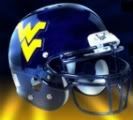Post by elp525 on Oct 14, 2011 8:56:13 GMT -5
Friday October 14, 2011
by Mike Casazza
Charleston Daily Mail
MORGANTOWN, W.Va. -- West Virginia has the fourth-best passing offense in college football and the best in the Big East.
Quarterback Geno Smith leads the league in passing yards per game and is No. 5 nationally.
Six players in the nation average more total offense per game than the junior from Miramar, Fla.
Of all those facts, it's the fact that he has more time in Dana Holgorsen's system that matters most to the WVU coach.
"He's a great player, but he's going to continue to get better and better over this next year-and-a-half to the point that you'll see a finished product," Holgorsen said. "Right now, you're not looking at a finished product."
Given Smith's success and his legitimate chance to set WVU's single-season and career records for attempts, completions, yards and touchdowns, it's difficult to envision Smith making such dramatic strides.
Yet it's real and Holgorsen, who often points to his past successes as an offensive coordinator, doesn't need to look too far back to explain why.
Holgorsen mentored Houston quarterback Case Keenum and Oklahoma State quarterback Brandon Weeden. Both have better completion percentages and passing efficiency ratings.
Both are ranked higher in passing yards per game and total offense per game. Both lead offenses that rank higher in passing, total and scoring offense.
"They've taken more snaps in the system," Holgorsen said. "When I left Houston and Oklahoma State, they kept the same system for a reason. They have the same guy doing the same system, Case for four years now and Brandon for two years now. You're seeing some pretty good football out of those guys. They're both 6-0 and they're playing at a very high rate. We're 5-1 and we're not playing at that rate right now offensively."
Holgorsen and his coaches have spoken during their open week in a way that attempts to quiet the excitement about the accomplishments on offense so far this season. It's not that they don't share some of the optimism and satisfaction about what the Mountaineers (5-1, 1-0 Big East) have done, but they know nothing right now is what it can eventually be later this season and then even later in the time spent together.
Time matters to what the Mountaineers do on offense.
"It will be fun a year from now watching what Geno, with that kind of experience under his belt and knowing exactly what to do and being a year advanced with everyone else around him, can do," Holgorsen said. "Then you can start talking about good offensive football."
The three quarterbacks are different and it is the time spent in the system that provides the greatest separation. Keenum is a sixth-year senior now who first learned Holgorsen's system in 2008. Weeden turned 28 today and spent several years playing minor league baseball. Smith started for the first time last season and then had to learn Holgorsen's system this past spring. He lacks Keenum's experience and Weeden's advantages of age, but that's about it.
"It's not a snap-of-your-fingers thing," Holgorsen said. "It's not like you can just show it to them on tape and say, 'Go do it.' Geno can do a lot of things that other people across the country can't do. His competitiveness is something that is irreplaceable."
That competitiveness could be Smith's greatest asset. Holgorsen calls it a "daily challenge," but it has rewards.
"Geno won't say anything at times because he thinks he can do every play," said WVU quarterbacks coach Jake Spavital, who was Holgorsen's graduate assistant at Houston and Oklahoma State. "But that's OK, to a certain extent. It's not like he's repeating the same mistakes over and over."
Smith's three interceptions come with explanations. One against Maryland came when Ivan McCartney let the ball bounce off of his chest and into a cornerback's grasp. One against LSU was a pass that went through Tavon Austin's hands and bounced off his facemask to a safety. A second against LSU was a low pass tipped and then intercepted by a cornerback.
By comparison, he's made few critical errors and far more impressive throws and decisions. There is value in having a quarterback who is more rebel than robot.
A year ago, Oklahoma State played Texas A&M and one lesson during the week was how to react when the Aggies played a single high safety. Weeden was told not to throw in that direction, but decided to ignore it when he saw it in a game.
It ended up going for a touchdown in a 38-35 win. Those are the things the other two quarterbacks have and Smith hopes to acquire.
"They know exactly what to do with the ball and know exactly what we're trying to get accomplished," Holgorsen said. "They understand it a little bit better than Geno does right now. Geno can do some things that those guys can't do, but they understand it a bit more just based on experience."
by Mike Casazza
Charleston Daily Mail
MORGANTOWN, W.Va. -- West Virginia has the fourth-best passing offense in college football and the best in the Big East.
Quarterback Geno Smith leads the league in passing yards per game and is No. 5 nationally.
Six players in the nation average more total offense per game than the junior from Miramar, Fla.
Of all those facts, it's the fact that he has more time in Dana Holgorsen's system that matters most to the WVU coach.
"He's a great player, but he's going to continue to get better and better over this next year-and-a-half to the point that you'll see a finished product," Holgorsen said. "Right now, you're not looking at a finished product."
Given Smith's success and his legitimate chance to set WVU's single-season and career records for attempts, completions, yards and touchdowns, it's difficult to envision Smith making such dramatic strides.
Yet it's real and Holgorsen, who often points to his past successes as an offensive coordinator, doesn't need to look too far back to explain why.
Holgorsen mentored Houston quarterback Case Keenum and Oklahoma State quarterback Brandon Weeden. Both have better completion percentages and passing efficiency ratings.
Both are ranked higher in passing yards per game and total offense per game. Both lead offenses that rank higher in passing, total and scoring offense.
"They've taken more snaps in the system," Holgorsen said. "When I left Houston and Oklahoma State, they kept the same system for a reason. They have the same guy doing the same system, Case for four years now and Brandon for two years now. You're seeing some pretty good football out of those guys. They're both 6-0 and they're playing at a very high rate. We're 5-1 and we're not playing at that rate right now offensively."
Holgorsen and his coaches have spoken during their open week in a way that attempts to quiet the excitement about the accomplishments on offense so far this season. It's not that they don't share some of the optimism and satisfaction about what the Mountaineers (5-1, 1-0 Big East) have done, but they know nothing right now is what it can eventually be later this season and then even later in the time spent together.
Time matters to what the Mountaineers do on offense.
"It will be fun a year from now watching what Geno, with that kind of experience under his belt and knowing exactly what to do and being a year advanced with everyone else around him, can do," Holgorsen said. "Then you can start talking about good offensive football."
The three quarterbacks are different and it is the time spent in the system that provides the greatest separation. Keenum is a sixth-year senior now who first learned Holgorsen's system in 2008. Weeden turned 28 today and spent several years playing minor league baseball. Smith started for the first time last season and then had to learn Holgorsen's system this past spring. He lacks Keenum's experience and Weeden's advantages of age, but that's about it.
"It's not a snap-of-your-fingers thing," Holgorsen said. "It's not like you can just show it to them on tape and say, 'Go do it.' Geno can do a lot of things that other people across the country can't do. His competitiveness is something that is irreplaceable."
That competitiveness could be Smith's greatest asset. Holgorsen calls it a "daily challenge," but it has rewards.
"Geno won't say anything at times because he thinks he can do every play," said WVU quarterbacks coach Jake Spavital, who was Holgorsen's graduate assistant at Houston and Oklahoma State. "But that's OK, to a certain extent. It's not like he's repeating the same mistakes over and over."
Smith's three interceptions come with explanations. One against Maryland came when Ivan McCartney let the ball bounce off of his chest and into a cornerback's grasp. One against LSU was a pass that went through Tavon Austin's hands and bounced off his facemask to a safety. A second against LSU was a low pass tipped and then intercepted by a cornerback.
By comparison, he's made few critical errors and far more impressive throws and decisions. There is value in having a quarterback who is more rebel than robot.
A year ago, Oklahoma State played Texas A&M and one lesson during the week was how to react when the Aggies played a single high safety. Weeden was told not to throw in that direction, but decided to ignore it when he saw it in a game.
It ended up going for a touchdown in a 38-35 win. Those are the things the other two quarterbacks have and Smith hopes to acquire.
"They know exactly what to do with the ball and know exactly what we're trying to get accomplished," Holgorsen said. "They understand it a little bit better than Geno does right now. Geno can do some things that those guys can't do, but they understand it a bit more just based on experience."





